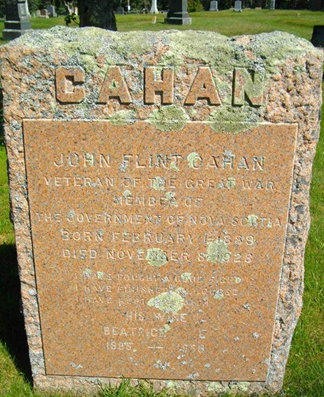
copyright © Wartime Heritage Association
Website hosting courtesy of Register.com - a web.com company
Wartime Heritage
ASSOCIATION
Remembering World War I
Yarmouth Connections
John Flint Cahan


Name:
John Flint Cahan
Rank:
Captain
Service Number:
Officer
Service:
1st Canadian Pioneer Battalion,
Canadian Expeditionary Forces
Date of Birth:
February 1, 1889
Place of Birth:
Halifax, Nova Scotia
Date of Enlistment:
November 10, 1915
Place of Enlistment:
Winnipeg, Manitoba
Address at Enlistment:
Halifax County, Nova Scotia
Age at Enlistment:
26
Height:
6 feet, ½ inch
Complexion:
Fair
Eye Colour:
Grey
Hair Colour:
Fair
Occupation:
Civil Engineer
Marital Status:
Married
Religion:
Presbyterian
Next of Kin:
Mrs. Beatrice E. Cahan (Wife), Dartmouth, NS (at enlistment)
Yarmouth, NS (at his time of death)
Date of Discharge:
September 9, 1919
Age:
30
Date of Death:
November 8, 1928
Age:
39
Cemetery:
Riverside Cemetery, Hebron, Yarmouth Co., Nova Scotia
John Flint Cahan was the son of the Honorable Charles Hazlitt Cahan (1856-1944) and Mary J. Chisholm
(1854-1915), the brother of Charles Hazlitt Cahan Jr. (1887-1970), and Lois Theresa Cahan (1892-1964),
the husband of Beatrice Eleanor (Davies) Cahan (1885-1958), and the father of John F. Cahan (1913-
1961), Freda Cahan (b. 1915), and Jaqueline Cahan (b. 1920). John’s father was Director of Public
Safety for Canada during World War I.
Prior to his active enlistment in WWI in November 1915, he enlisted June 20, 1915, and served with the
6th Field Company of the Canadian Engineers but was demobilized August 7, 1915.
John served in Canada, England, and France with the 1st Canadian Pioneer Battalion. He completed a
Grenade Course at the Canadian Military School at Shorncliffe in England from January 5th – January 29,
1916. He was wounded in action by a shell fragment injury to the spine on September 17, 1916. He was
considered dangerously ill for over a month when his status was upgraded to seriously ill October 2,
1916.
The injury to his spine robbed him of the ability to move his legs below the knees. Beyond his lost
mobility, other vital functions suffered as well.
Cahan was discharged with severe wounds to his spine from the war, with his demobilization being
administered by the ISC (Invalided Soldier’s Commission) beginning August 30, 1918, and he was
medically discharged September 9, 1919.
After the war, in 1921, John was living with his wife Beatrice in Hebron with his three children and two
servants, Evelyn White and Emily Jeddry.
John served as the Member of the Legislative Assembly for Yarmouth, Nova Scotia from 1925-1928.
Captain John Flint Cahan spoke at the unveiling of the
Yarmouth War Memorial (Yarmouth Cenotaph) on June
9, 1923, delivered the unveiling address. Still suffering
from injuries which he had received on the front, he
was compelled while speaking to remain seated. His
brief oration was delivered with gripping forcefulness
and was most impressive. It was a message to the
living urging them to strive always be patriotic and to
be in readiness to serve their country in a time of
need.
Captain Cahan died in Halifax, NS on November 8,
1928. His cause of death is documented in the Canada,
War Graves Registers Cause of Casualty records as
“gunshot wound of spine – Pyelonephritis” (kidney
infection) and related to military service.
Sources:
findagrave
Library and Archive Canada





- World War I - Menu
- WWI Stories and Articles
- Photos - Yarmouth Soldiers
- Selection of World War I Songs
- WWI Casualties of Yarmouth, NS
- Those Who Served - Yarmouth, NS
- WWI Casualties Digby Co. NS
- WWI Casualties Shelburne Co. NS
- Merchant Mariners (1915) Yarmouth, NS
- Canadian Forestry Corps - Non Yarmouth Birth/Residence Enlistments
- US Draft Registry - Yarmouth NS Born


- World War II - Menu
- WWII Stories and Articles
- Telegraphist Air Gunners
- WWII Casualties of Nova Scotia
- US Casualties with NS Connection
- Far East/Pacific Casualties with NS Connection
- Merchant Navy Casualties Nova Scotia
- Nova Scotia WWII Casualties Holten Canadian War Cemetery
- D-Day Casualties - Nova Scotia
- CANLOAN Program Casualties - Nova Scotia
- Battle of the Bulge Casualties - Nova Scotia
- WWII Casualties Yarmouth NS
- Yarmouth Casualties - RCAF RAF Canadian Army WWII
- Yarmouth Co., Marriages WWII
- Casualties Non-Born/Residents with Connection to Yarmouth Co., Nova Scotia.
- WWII Casualties Digby Co., NS
- Non-Nova Scotian WWII Casualties Buried in Nova Scotia
- WWII RCAF Casualties Aged 16-18
- Brothers/Sisters Who Served - World War II













